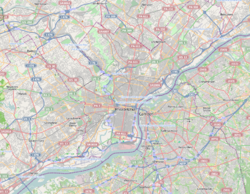Uptown Theater (Philadelphia)
|
Uptown Theater and Office Building
|
|
 |
|
| Location | 2240-2248 N. Broad St., Philadelphia, Pennsylvania |
|---|---|
| Coordinates | 39°59′14″N 75°9′23″W / 39.98722°N 75.15639°WCoordinates: 39°59′14″N 75°9′23″W / 39.98722°N 75.15639°W |
| Built | 1927 |
| Architect | Magaziner, Eberhard & Harris |
| Architectural style | Art Deco |
| NRHP Reference # | 82003817 |
| Added to NRHP | July 22, 1982 |
The Uptown Theater in Philadelphia, Pennsylvania, also known as Uptown Theater and Office Building, is an Art Deco building built in 1927. It was designed by the Philadelphia based architectural firm of Magaziner, Eberhard & Harris. The Uptown Theater is located on 2240 N. Broad Street. It became a major venue on the chitlin circuit, from 1951-1978. It was listed on the National Register of Historic Places in 1982.
It briefly reopened as a church in the 1980s until water damage occurred and caused it to close in 1991. In 2001, the Uptown Entertainment and Development Corporation bought the building with plans for renovation.
Opened on February 16, 1929, the 2,040 seat, 50,000 square foot Uptown Theater was built for sound, specifically the new talkies of the time, made by Warner Brothers. Designed by Louis Magaziner, it featured a lavish interior, with four floors of office space above. The interior consisted of stained glass, high ceilings, and terracotta. As the industrial age peaked in America, North Philadelphia became a working man's town. A large influx of European immigrants moved to the northern part of the city, and moved into the newly developed rowhomes.
In addition to the new immigrants, North Philadelphia also became the home to many fashionable mansions of the upper and upper-middle class. Executives from nearby factories lived in Victorian brownstones some with turrets and mansard roofs which lined the streets of North Philly. Along Broad Street were the grand mansions of many famed industrialists. Lower North Philadelphia in particular housed a number the nouveau riche; ambitious first or second generation immigrants or that had made their fortunes starting manufacturing firms.
The theater was originally built for the nouveau riche of the area. Unknowingly, it opened up on the eve of the Great Depression, which in turn had a great effect on the neighborhood. Over the next few decades The Great Depression, outsourcing, and white flight took their toll on North Philadelphia in a fashion similar to other major US cities of the mid to late 20th century, if not in a more pronounced fashion. While some small areas had long housed primarily African-American residents, redlining, racist loan companies, and rising unemployment led white residents out of the city, and forced blacks in. Black doctors, lawyers, politicians and preachers took over the grand mansions along Diamond Street, while middle and lower class blacks moved into the rowhomes that were once predominately white.
...
Wikipedia



